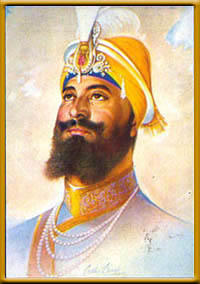Sikh.

This is coolbert: When the two GI's [Gordon and Shughart] that won the Medal of Honor in Somalia [posthumously] were awarded the medal, this quote of the Sikh guru Gobind Singh was cited:
"The greatest warrior is the one who fights for a people he does not know, for a cause that he does not understand."
And in the case of the two GI's in Somalia, this is undoubtedly true, is it not?
The Sikhs are an example of a people that have totally adopted the warrior mentality. The entire life for a male is based upon martial concepts of behavior. The famous five "K's" of the Sikh are indicative of this. At all times the devout Sikh must wear a turban, not cut his hair or beard, wear a bracelet, and carry a comb and a dagger. Numbering about forty million in a population of over one billion, the Sikhs are more than well represented in the most robust and vibrant sectors of Indian life. Especially in the military, where Sikh units excel, just as they did under the British Raj. In civilian life too the Sikh population is very entrepreneurial and successful.
Perhaps the best example of the martial mentality of the Sikhs is exemplified in the Sikh guru mentioned above, Gobind Singh. The tenth and last [?] of the Sikh gurus, Gobind was renowned for his military ability. Adept at archery, sword play, and horsemanship. And also as a philosopher [guru, teacher]. This life style is not in conflict in oriental societies [I would classify India as an oriental society] as it would thought to be in a western society. The Japanese for one also say "sword and pen in accord". Here is something from the life of Gobind Singh that I find to be fascinating. At one point in his life, he was deserted by forty [40] disciples who left him in the midst of a battle, only to return and become martyrs. This forty is reminiscent of the forty that is constantly found in the Bible. Forty is a term used to signify something of great significance. Jesus spent forty days in the wilderness. It rained forty days and forty nights. The Jews spent forty years in the wilderness. Etc. How is it that the number forty also appears in the chronicles of Gobind Singh. Is it a coincidence or what? I think not!
"The most valorous part in this battle was played by a group of 40 Sikhs who had deserted the Guru at Anandpur during the long siege, but who, chided by their womenfolk at home, had come back under the leadership of a brave and devoted woman, Mai Bhago, to redeem themselves. They had fallen fighting desperately to check the enemy's advance towards the Guru's position. The Guru blessed the 40 dead as 40 mukte, i.e. the 40 Saved Ones."
To read more about Gobind Singh, click here.
coolbert.

0 Comments:
Post a Comment
Subscribe to Post Comments [Atom]
<< Home